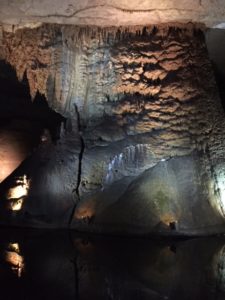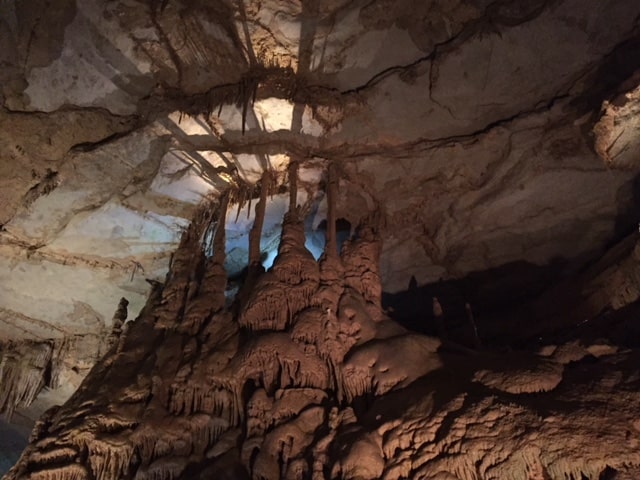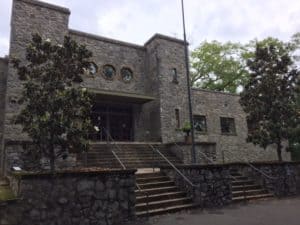I headed to Northern Alabama after my time in Middle Tennessee because Lake Guntersville State Park was the location of the 3rd annual Oliver Trailer Rally. As a new owner, I wanted to attend. One of the activities some of the group did was a zip line where we were high in the sky. I previously wrote about the rally.
The rally lasted four days. I stayed for four weeks. The campground is on the shore of Lake Guntersville which makes for some lovely morning walks and evening sunsets. In 2011, a horrible tornado ripped through the area and the campground sustained heavy damage. Lots of trees ripped up. Only one bathhouse survived. That’s the bad thing. The silver lining, though, the campground was re-built.
I would definitely stay there again. In fact, I probably will. At the dinner on the last day of the rally, the organizers announced the 2019 rally would be at the same place. Dates are supposed to be announced anytime now (for anyone who might be interested—and you don’t have to be an owner to attend).
On top of the hill behind the campground is a golf course, a chalet and a hotel. For one little campground, they seem to have everything, including a small water treatment area surrounded by a fence. Inside the fence you find three emus and two donkeys. File that under “things that make you say Hmm.”
Guntersville
Lake Guntersville State Park is 15 minutes outside of the town of Guntersville with a population of 10,000. There isn’t a lot of touristy stuff to do. However, they make up for it with all the outdoor activities of area. Fishing, hiking, hunting, birding and boating.
During the month of June, the Chamber of Commerce offered walking tour. Guided or self-guided, I love me a walking tour. Sadly, I must report I didn’t make it to this walking tour. I am just not tough enough to spend an hour or two in the humid 90+ degree weather.
I visited the Guntersville Museum. It’s in the Alabama National Guard Armory, built under President Roosevelt’s Works Progress Administration (WPA) in 1936. It was used for drills, training and classroom instruction. When a new armory was built in the 1970s, the building was used as the fire station until the mid-1980s. After renovations, the museum moved to the building in 2006 and, the year before they moved in, the building was listed with the National Registry of Historic Places.

Civil War drum on display at museum. Drummer Boys played an important role in the Civil War. The drummer told the soldiers how and when to maneuver over the battlefield. They could be heard over the roar of the fighting.
To be honest, the museum doesn’t need a building the size of the former armory to hold its collection. But it was refreshing not to have displays crammed together. Lots of meandering space. Lots of information about the area and, in particular, the dam and bridge that really made the area what it is today. On a loop, they run a PBS show made about the dam.
I also learned the town embraces their connection to Will Rogers, the humorist, even though Rogers was neither born nor lived in Guntersville. The connection? Rogers’ great grandfather was the town’s founder, John Gunter. An interesting tidbit: both died in 1935. Rogers died in a plane crash in Barrow, Alaska, the northern most town in Alaska and one I was lucky enough to visit it during my time there.
The cost of the museum? Free. My favorite amount to pay.
Cool Caverns Deep in the Mountain
On another hot day in Northern Alabama, I drove to Cathedral Caverns State Park, 30 miles from Lake Guntervsille State Park. Hot day or not, the outside temperature didn’t matter because the temperature inside the mountain was cool.
Access to Cathedral Caverns are only with a tour guide. You aren’t allowed to just wonder alone. However, all of the history and learning provided happens on the three-quarter walk into the caverns. You take the return walk at your own pace. Some in my group walked straight out. While others, including me, walked slow, stopping for more looks and photos. The tour guide brought up the rear to ensure everyone exists and to turn off lights along the way.
Total distance walked on the tour is 1.5 miles. And you’ll want to note the few steep-ish inclines and declines. The rocks are wet so in some places I held the handrail and took tiny steps to make sure my feet didn’t slide out from under me. In Alaska, we called that particular walk (though done over snow and ice) the Alaska Shuffle. It isn’t elegant but better than taking a tumble.
The pathways are wide enough for wheelchairs so, technically, the tour is handicap accessible. But it might be a challenge to push a wheelchair up the inclines or control it coming back down. That said, they are accommodating.
That said, we caught the tour group ahead of us at the turnaround. A few of the senior citizens decided the walk in had been demanding enough and didn’t feel they could walk back. Their tour guide summoned a golf cart to retrieve them. I loved that.
History of the Caverns
 Indians used the caverns to get out of the heat. During their time, they only had access to the large opening mouth (128 feet wide and 25 feet tall) and first two rooms because the rest was under water. Digs show Indians present as recently as 200 years ago and as long back as 8,000 years ago.
Indians used the caverns to get out of the heat. During their time, they only had access to the large opening mouth (128 feet wide and 25 feet tall) and first two rooms because the rest was under water. Digs show Indians present as recently as 200 years ago and as long back as 8,000 years ago.
Locals of the area knew of the cave long before it was “discovered,” using it for summer picnics and concerts. Folklore of the area says that during America’s Civil War, draft dodgers and deserters hid out inside the caves. During WWII, emergency food rations were stored in the caves. One drum remains to show what they looked like. Never opened. I wonder what’s in it? But all of this, too, was in the mouth of the caverns and in the first two rooms.
The discovery of the caverns is credited with spelunker (cave exploring hobbyist), Jacob “Jay” Gurley. In 1952, he and a fellow spelunker found the cave and crawled through more than had ever been explored prior. Inside the cavern 2,600 feet, Gurley made this statement:
You know, I think we are the first to get in this far and finding this thing – just seeing it – is probably the most important thing we will ever do. Somebody must build walkways so others can see it.

Can you see the damage from the 1812 earthquake? It’s the horizontal crack through the growing formation.
The tour guide painted a vivid and detailed picture of Gurley and his obsession with the caverns. Gurley sold everything he owned, quit his job, struck a deal with the land owner and then worked at opening the caverns to the public. He opened it in 1955 and ran his attraction until 1974. Sold at auction in 1975, the new owner ran it until he sold it to the State of Alabama in 1987.
It took 13 years for the state to reopen it as Cathedral Caverns State Park in May 2000. Funding, in part, accounted for the delay but lots needed done. Paths paved. Handrails installed. Lighting installed for both walking and viewing the formations. In fact, when you get to the end of the tour at the turnaround point, the tour guide said there are two more rooms further but, after 13 years and no more money, they decided not to prepare those for public viewing. Maybe someday.
 Speaking of the turnaround point of the tour. One of the coolest and spine-tingling things on the tour happened there. To give us an idea of what the caverns are truly like, the tour guide turned off the lights illuminating the Cathedral Room.
Speaking of the turnaround point of the tour. One of the coolest and spine-tingling things on the tour happened there. To give us an idea of what the caverns are truly like, the tour guide turned off the lights illuminating the Cathedral Room.
Pitch black. Cool air. And silence.
Before he turned the lights back on, he turned on his flashlight. Then he partially covered it with his hand to simulate a flashlight of the 1950s. It gave us an idea of Gurley’s available light as he crawled through the caverns. To make the caverns tourist-worthy, Gurley chiseled, pounded, dynamited and moved tons of rock and sand to create the original trails and pathways. Gurley’s first times in the caverns were on his belly with dim light.
Geological Happenings

One of the largest stalagmites in the world named Goliath. Can you see the deep crack? It’s from the 1812 earthquake.
If you have trouble imaging the caverns being underwater, there is proof. A shark’s tooth embedded in the ceiling near the entrance. That’s the only one we saw, but there are 11 shark teeth in the caverns. Additionally, we saw other water-based fossils in the stone.
Damage resulting from the 1812 earthquake is evident in several places. Most notably in the deep large crack of Goliath.
The Names
Gurley named each of the caverns’ rooms as were many of the formations.
The first room, he called Big Rock Canyon. Frozen Waterfall, named because of how it looks. It isn’t actually a waterfall. Or frozen. Goliath, a stalagmite column, measures 45 feet tall and nearly 250 feet in circumference. It’s one of the world’s largest stalagmite formations. The river than runs through the mountain and under the gift shop is called Mystery River, and there remain things they don’t know about the river.
But it was Gurley’s wife who named the room which would become the name of the state park. She liked the caverns well enough but was doubtful about giving up their entire lives for rocks. That was until he introduced her to one particular room. She stood in awe and proclaimed the room Cathedral Room. To her eye it looked like, yep, a cathedral. And it does.
So many stories about Gurley and so much geologic information came with the tour. Let me take a moment to say: nothing beats an excellent tour guide to make the difference between a good tour and an amazing one.
If I’ve learned nothing else in my months as a tourist, it is that.
Good Luck or Bad Luck?
Things drip. The wet pathway comes from water drips from the ceiling. We were told not to be startled if water dripped on us.
In fact, if a drop of water falls on you during the tour, call it a Cave Kiss. And it is good luck. You know it’s a Cave Kiss because the drop will be cold.
If, however, if you feel a not-cold drop on you, it means bad luck. It also means a bat just pooped on you. I never saw a bat. But I remained alert for the bad luck droppers.
I am happy to report I received one or two Cave Kisses during my visit. Then again, in this life, I have received thousands of Cave Kisses.

My favorite formation was all about the lighting. I loved that the rock formations’ shadows fell on the ceiling instead of the floor.











I had only been to caverns in NY. We traveled through the caverns by boat. They were beautiful and we were not allowed to take photos. Now I have been to caverns in Alabama and they are just as beautiful. Thank you. Marie
Thank you. I had no idea there were ones big enough for a boat. But I suppose it makes sense since they are carved out by rivers.